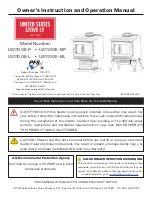
Stove Installation
(for qualified installers only)
11
© Travis Industries
100-01177
4060802
Chimney Connector Requirements
•
Chimney connector is required from the flue collar of the stove to the factory-built chimney (see
Figure 7) or masonry chimney (see Figures 13, 14, and 15).
•
The chimney connector must be 6” diameter and a minimum 24 gauge black steel, 26 gauge blued
steel, or one of the reduced-clearance connectors listed on page 8.
NOTE: Aluminum or galvanized steel is not allowed – these materials can not withstand the flue
temperatures and may give off toxic fumes when heated.
NOTE: Standard residential installations may use single-wall connector (Mobile-Homes may
not
).
•
The chimney connector may not pass through a ceiling, attic, roof, closet, or any other concealed
space (use listed UL 103 HT chimney – see “Chimney Requirements for details).
DO NOT USE
CONNECTOR PIPE AS CHIMNEY
.
•
The chimney connector should be as short and direct as possible. No more than 180
o
of elbows (two
90
o
elbows, or two 45
o
& one 90
o
elbow, etc.) may be used for the entire system (connector and
chimney).. Horizontal runs should slope upwards 1/4” per foot and be a maximum 36” long.
•
The chimney connector must be installed with the crimped end pointing downwards (see Figure 7).
This prevents creosote from leaking to the exterior of the pipe.
•
The chimney connector must be fastened to the stove and each adjoining section (and chimney).
•
In cases where the chimney connector must be passed through a combustible wall or partition, the
following NFPA 211 method may be used if local building codes permit. Check with local authorities
before installation to insure all necessary requirements have been met. Figure 6 details a wall pass-
through based on the NFPA 211 standard.
NFPA 211 Wall Pass-Through
(see NFPA 211 for a full description)
12” Min.
12” Min.
Combustible Materials
Brick
Fire Clay Thimble
Figure 6












































